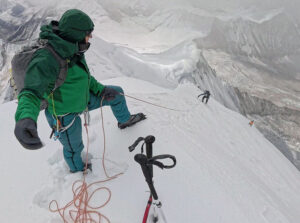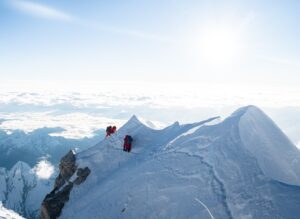Most climbers currently focused on the 14×8,000’ers are waiting intently for news from Shishapangma, the only 8,000m peak totally within Tibet. Closed to foreigners since 2019, there were rumors earlier this year of a possible reopening in spring 2023.
However, China’s strict zero COVID policies have dampened those early expectations. Imagine Nepal had announced a commercial expedition to Shishapangma next spring but has finally canceled because of the uncertainty. Instead, they are offering an Annapurna climb instead. Other Nepali agencies have deferred their Shishapangma hopes by tentatively offering a fall 2023 climb instead.
Edurne Pasaban’s last 8,000’er
Shishapangma was the last 8,000’er for Edurne Pasaban of Spain, the first woman to summit all 14. “It was also the summit that took me more attempts – a total of five!” she recently told ExplorersWeb. “The main reason for the failures was that we underestimated the peak. Since it was lower and theoretically easy, we always went there with little time, poorly acclimatized…but an 8,000’er is an 8,000’er, no matter what.”
Pasaban tried three times from the British route on the south side, and two from the normal, northern side. She finally succeeded in 2010, from the north. Pasaban never considered climbing with oxygen. (She has only used it on Everest.)
“In my time, no one [used O2 on Shishapangma],” she said. “In fact, the first time I saw O2 bottles on Shishapangma was with Miss Oh’s team. At that time, she was already in the race for the 14×8,000’ers. On summit day, we had to turn around in bad weather, but they continued and summited, mainly thanks to the O2.”
Oh Eun-Sun of South Korea was Paraban’s closest rival for the first woman to complete the 14×8,000’ers. She did finish first, she claimed, but that was not the conclusion either of Elizabeth Hawley of The Himalayan Database or of ExplorersWeb.
At that time, we conducted a thorough investigation of Oh’s Kangchenjunga summit pictures. We concluded that she never reached the peak’s highest point. The distinction of being first then went to Pasaban.
“That summit was a great joy because the whole team was together and it was the end of my quest,” Pasaban said. “I recall a sense of fullness…then a slight feeling of unease when I thought, ‘Now what?'”

Now what? Edurne Pasaban on the summit of Shishapangma, her last 8,000’er. Photo: Edurne Pasaban
Climbers’ guide: The approach trek and Base Camp (5,760m)
As with other Tibetan 8,000’ers, there is a Chinese Base Camp at 4,900m, which can be reached by road, then an Advanced Base Camp one day’s hike (18km) away. This is the actual climbers’ Base Camp.
You must acclimatize before coming here. Pasaban did so on another peak. Others spend a couple of days mid-drive in Nyalam or trekking at altitude. Many do this in Nepal before flying to Tibet.

Chinese Base Camp by the roadside near Shishapangma. Photo: Edurne Pasaban
Base Camp’s location on the barren Tibetan plains means that it is often very windy. From BC, Shishapangma shows its north side and the NW Face route ahead.

The small Base Camp, with solitary Shishapangma behind. Photo: Edurne Pasaban

Shishapangma Advanced Base Camp with its characteristic penitentes on the glacier.
Base Camp (5,760m) to Camp 1 (6,350m)
“From the Base Camp, there is an easy walk to what we called “Los Penitentes” at about 5,900m. It’s filled with these hard snow formations at the foot of the glacier,” Pasaban recalled. “There, we left a depot with our crampons, ice gear, and expedition boots.”

Time to crampon up before stepping onto the glacier. Photo: Edurne Pasaban
Once on the snow-covered glacier, you find your way through more penitentes and seracs. It is wise, says Pasaban, to use bamboo wands to mark the way.
“The route slowly gains altitude over undulating slopes until Camp 1. Overall, the route is pretty straightforward,” Pasaban recalls. The only obstacles are some crevasses, which take time to go around.

Easy terrain toward Camp 1. Bamboo wands mark the route. Photo: Edurne Pasaban
Camp 1 (6,350m) to Camp 2 (6,800m)

Camp 1 on Shishapangma. Photo: Edurne Pasaban
This section is not much different from the previous one. Once acclimatized, teams can just skip Camp 1 on their final rotations and go all the way to Camp 2, some 500m higher.

A gradual snow slope leads up toward Camp 2. Photo: Edurne Pasaban

Camp 2 on Shishapangma, seemingly in the middle of nowhere. Photo: Edurne Pasaban
Camp 2 (6,800m) to Camp 3 (7,300m)
At first, the terrain is similar to the previous stages. Any hardship comes only from bad weather until nearly Camp 3.
“Just before Camp 3, the terrain gets steep and the route surmounts a rocky band some 250m high,” says Pasaban. “Some teams set Camp 3 below that section, but I do not recommend it. It is better to put that obstacle behind you. Depending on the conditions, you may want to fix some rope. In our case, we did, but we were thinking of making our descent easier.”
Except in extraordinary conditions, a convenient snow ramp always leads up the rocky barrier.

The end of the nearly flat terrain and the headwall in front, on the way to Camp 3 on Shishapangma. Photo: Edurne Pasaban
Routes from Camp 3 (7,300m) to the main summit (8,027m)

Reaching Camp 3 on Shishapangma, right above the rocky face. Photo: Edurne Pasaban
Camp 3 is the last and highest of the set camps. It is also the place to make some decisions. The classic route, opened by a large Chinese team led by Hsu Ching in 1964 (Shishapangma was the last 8,000’er to be summited) follows the long north ridge all the way to the summit. The problem is that Shishapangma has three distinctive summit points, and the true summit is the furthest away from that route.
The going is usually okay past the first foresummit (marked by a pointy rock, Pasaban explained) and until the central summit (8,008m). That is the end point for many expeditions, happy to have passed the 8,000m mark but not willing to deal with the long, often unstable knife-edge that leads to the highest point of the mountain.
The alternative, which has become more popular with teams that really want to reach the main summit, is to turn left before the ridge, shortly after leaving Camp 3. You then traverse under a maze of seracs and find a way toward the East Ridge (there are several possible variations). The East Ridge ends close to the main summit.

Pasaban’s team got this picture from the late Inaki Ochoa de Olza and followed his route, in green. The orange line shows the classic route across the central summit. Photo: Edurne Pasaban
“I had information and a photo from Inaki Ochoa de Olza’s family [Ochoa had died on Annapurna two years earlier],” Pasaban said. “We followed what we think is the same route he took when he soloed the mountain in 2006.”
There are several variations in that area, as shown in the topo below.

There are several lines on the upper sections of Shishapangma’s normal route, as shown in this topo by 8000ers.com. Inaki Ochoa’s (and Pasaban’s) route is in black.
That section requires some attention to avoid crevasses under the seracs, but it is otherwise not difficult, Pasaban said. “We got to the summit ridge at the same small col that climbers reach from the South Face, just metres away from the peak’s highest point.”

From Camp 3, Pasaban traversed under the summit ridge in order to access the East Ridge and summit area. Photo: Edurne Pasaban
Below, a video of Edurne Pasaban and her team arriving at the summit of Shishapangma:
Little or no rope needed
Shishapangma has so few technical difficulties that it can often be done without ropes. This makes logistics much easier. “We only fixed some metres of rope on the cliff below Camp 3, in order to ease our descent in case conditions worsened,” explained Pasaban. “On the summit ridge, we roped up in pairs and climbed together, more as a precaution and out of habit.”

Roping up in low visibility on unfamiliar terrain, as a precaution against hidden crevasses. Photo: Edurne Pasaban
In a hurry to complete the 14×8,000’ers as soon as possible, Pasaban used a strategy that was considered risky at the time. She planned to do two 8,000m peaks in a single season. So before heading for Shishapangma, she climbed Annapurna.
“Looking at how things are done now, it looks very average,” she laughs. “Annapurna was a technically difficult mountain and therefore was our primary goal.”
The team managed to finish with Annapurna in time to try Shishapangma, thereby taking advantage of their acclimatization.
Pasaban summited Shishapangma with fellow Basque Alex Txikon, mountain guide Nacho Orviz, and Pasaban’s cousin, Asier Izaguirre. The team also included Mingma Sherpa and Pasang Sherpa, with whom she still keeps in touch.
All her career, she climbed with people she knew and trusted, including several fellow 14×8,000m summiters Ferran Latorre, Silvio Mondinelli, and Juan Oiarzabal.
Currently, Pasaban runs her own outdoor company and gives corporate talks. Asked about how the 8,000m situation has changed, she rolled her eyes. “I don’t often follow current Himalayan news but when I do, I can’t help thinking how fortunate I was to climb when I did.”






